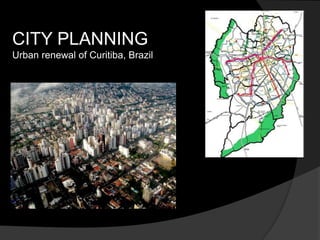
Group 9
- 1. CITY PLANNING Urban renewal of Curitiba, Brazil
- 2. Indigenous period In the past, the region where today is the city of Curitiba was a region of exuberant forest. The first inhabitants of the region were the indigenous tribe Tingüi, by the Tupi-Guarani nation. At the beginning of the Christian Era, the Plateau Curitibano was inhabited by peoples potters. Subterranean houses, found at archaeological sites on the outskirts of Curitiba show adaptation of native to the adverse conditions of climate, as the cold wind, frost and snow.
- 3. Colonization period The first 10 years the 16th century marked the beginning of a war of conquest of Europeans against the indigenous peoples who inhabited the plateaus of southeastern and southern brazil Were Portuguese and Spanish expeditions in search of precious metals and stones, and Indians to enslave.
- 4. The region of Curitiba began to be populated by non-Indians around 1630. Paranaguá people discovered alluvium gold , forming the village of "Our Lady of Light and God Jesus of Pine Forest", which was became in town in 1693. The name was changed to Curitiba in 1721. There is a legend telling that around 1648 a group of pioneers founded a small village near the Atuba River while searching for gold Curitiba officially became a town in 1812
- 5. Immigration period Waves of European immigrants started arriving after 1850, ( Germans, Italians, Poles and Ukrainians). In 1853, the south and southwest of the province of São Paulo are separated, forming the new province of Paraná, and Curitiba has become capital. The first Europeans to arrive in the region were of Portuguese origin, during the 17th century. They intermarried with the native people and with the African slaves. In 1828, the first German immigrants settled in Paraná. Typical house of Polish immigrant, in a park in the city Memorial of Japanese Immigration in the Japanese Square
- 6. Typical house of Polish immigrant, in a park in the city Immigrants from Poland first arrived in 1871, settling in rural areas near to Curitiba. Japanese immigrants starting arriving in the region in 1915. Curitiba received significant numbers of immigrants from Japan. Nowadays, there are about 40 thousand Japanese-Brazilians living in the city. Other immigrants, such as jewishes, Arabs from Lebanon and Syria, English, French, Russians and other Eastern Europeans also settled in Curitiba.
- 7. Renewal of Curitiba During the 20th century, especially after the middle, the city is going through a large increase in population and is consolidating as regional hub for trade and services. Curitiba's First Urban Plan: 1940s By the 1940s, Curitiba was experiencing rapid growth. Word of the region's thriving agriculture industry attracted new settlers from such nations as Japan, Syria and Lebanon. Now at three times its turn-of-the-century population, Curitiba was confronted with increasing demands for improved services, housing and transportation. The city hired French planner and architect Alfred Agache to help ease the growing pains. Agache expanded Curitiba's sewer system and rerouted its traffic patterns. Sweeping arclike patterns now radiated out from the city center to better manage the flow of cars and buses that were clogging city streets.
- 8. Unchecked Growth: 1960s Curitiba's population swelled to more than 430,000 people in 1960. It’s surrounding has agricultural industry .such as coffee (Scwartz, Hugh). After a series of frosts between 1952 and 1975 sent the industry into a downward spiral, workers began turning to Curitiba in search of employment. During this time Curitiba was characterized by a shortage of electricity, telephones, and paved streets. Only a third of the families living in Curitiba had access to sewers. And traffic was beginning to become more of a problem in the downtown area. In response to the influx of people, the mayor of Curitiba initiated a Master Plan design competition for the growing capital city. The winning team consisted of young idealistic planners and architects lead by Jaime Lerner.
- 9. Implementing the Master Plan: 1970s After his plan for Curitiba was adopted in 1968, leading architect Jamie Lerner created the city's first urban planning department to help organize and direct further redevelopment efforts. Among the department's innovations in the 1970s was Rua Quinze do Novembro, the heart of commercial Curitiba and Brazil's first pedestrian-only street. The city also adopted a trinary road design, called the Sistema Trinário, to minimize traffic in the city, whose population had now surpassed 600,000. The new system sandwiched a central two-lane street restricted to buses and local car traffic between wide, fast-moving one-way streets.
- 10. MAJOR COMPONENTS Connective corridors: “Concentric circles of local bus lines connect to five radial lines that go outward from the center of the city. On the radial lines, triple-compartment buses in their own traffic lanes carry 300 passengers each. They go as fast as subway cars, but at one-eightieth the construction cost. Designed to encourage density along the corridors, the system expands according to the needs of its riders. Specially marked bike and pedestrian paths 200 km of bike paths
- 11. Curitiba's Color-Coded Transit System Regional Buses Above-Ground Transit City Street Buses Express Service Health Care Transit Tourist Buses
- 12. large parks, patches, & preserves: Land reclamation and water recuperation are used to solve both environmental and social problems. Green zoning safeguards open spaces and stiff regulations protect every tree in the city. Nearly one-fifth of the city is parkland, and volunteers have planted 1.5 million trees
- 13. Neighborhood parks: Planning a city means correcting your course all the time … by allowing people to correct you. We wanted to build parks within a maximum of 500 meters of everybody’s home: the local people convinced us that we would do better to save the remaining forests … so we got our parks in one or two months instead of having to wait 20 or 30 years for the trees to grow. They have more than 1000 parks and 5 Anchor parks.